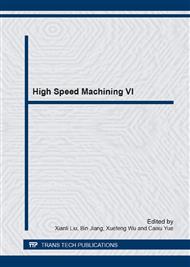p.596
p.601
p.607
p.613
p.619
p.627
p.633
p.639
p.644
Research on Surface Roughness in High Speed Face Milling Part 2: Experimental Validation of Prediction Model
Abstract:
The paper presents rigorous experimental validation results of the algorithm to predict work-piece surface roughness in face milling operation as developed in the Part 1. The experimental verification system consisting of various devices was established according to the given experimental conditions. Experimental parameters are set for steady face milling. Experimental data are collected through four experiments. These experimental data include the axial and radial run-out errors of each square insert with flat edge, the modal parameters of the face milling system, the Z-axial milling force and the measured surface contour of the milled work-piece. The trajectory of cutting teeth is calculated by the MATLAB software based on the static surface roughness model. Z-axial dynamic relative displacement between the tooth and the work-piece is obtained as the predicted dynamic surface roughness. By integrating the prediction results of static and dynamic models, the surface contour is predicted. Predicted and measured results are compared in the same figure and basically consistent. The work-piece surface roughness prediction model will be useful and valid in high-speed face milling.
Info:
Periodical:
Pages:
619-624
Citation:
Online since:
July 2014
Authors:
Price:
Сopyright:
© 2014 Trans Tech Publications Ltd. All Rights Reserved
Share:
Citation:


